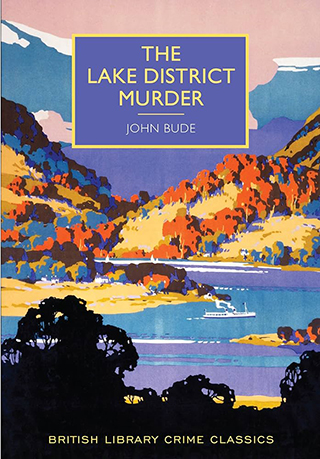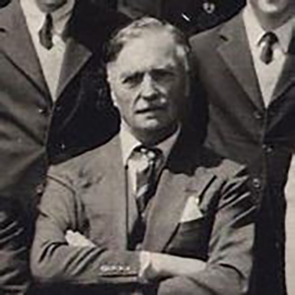I recently enjoyed reading Death on the Riviera, and on finding out that it was the fourth in a series, bought a copy of this one, The Lake District Murder, which is the first in the series. This one has a very different setting to the exotic French Riviera. It’s set in the Lake District in England, but not at the local beauty spots that tourists enjoy. It’s early Spring, it rains for most of the book, and the action takes place in the quiet rural areas inhabited by locals, not the tourist spots. Most of the characters are working class, there are no glamorous playboys or wealthy heiresses in this one.
I was a bit surprised at this. I think I was misled by the cover. The cover of my British Library Crime Classics edition is a reprint of a 1932 London and North Eastern Railway travel poster, showing a small steamer boat sailing on Ullswater (the second largest lake in the district, after Windemere), surrounded by the hills and mountains of the Lake District.
Another difference is that Meredith, Bude’s detective, is not with Scotland Yard in this book, and he’s not yet a Superintendent. He’s an Inspector based at Keswick, a market town in the district, reporting to a Superintendent in the slightly larger town of Carlisle. It’s noted at one point that this investigation is Meredith’s first unaided murder investigation. He gets his promotion to Superintendent in the final paragraph of the book. There are 17 years between books one and four, so there’s plenty of time for a move to Scotland Yard.
But there are also similarity between the books. Again there is a dual focus – murder and some other illegal activity (exact nature unknown to begin with). But this dual focus is better handled in The Lake District Murder. In Death on the Riviera the action starts with counterfeiting, and the murder comes very late in the book and is only tangentially related to the counterfeiting. In contrast, in this book the murder occurs directly because of the other illegal activity. Meredith starts with the murder enquiry, then turns his attention to the other crime when he runs out of direct leads with the murder, and eventually gains enough information to tie the criminals back to the murder.
No one could complain that it takes too long to get a body in this book. The first chapter opens with a local man running out of petrol in a remote area, hiking through the rain to nearby garage and finding the garage owner, Jack Clayton, dead. At first glance it looks like the death is a suicide – the body is slumped in a running car, covered by a coat, with a hosepipe going from the exhaust into the car. Suicide by asphyxiation seems the obvious verdict, but Meredith isn’t satisfied. There are just too many little points that he can’t reconcile with suicide, starting with Clayton’s tea laid out in his cottage, with the kettle boiled dry over the fire. The hosepipe is filthy, covered in oil, but Clayton’s hands are clean, looking like they’ve been washed for tea. Clayton is engaged, due to be married in only a few weeks, and the fiancée reveals to Meredith that they were planning on moving to Canada. Tickets for Canada were bought just a few days earlier. Clayton has a large bank account, with a balance over £2000. It’s surprising because the garage is in an out of the way area with little trade over winter, and his partner is known to spend most of the business’s profits at the local pub. Meredith gets approval to request an autopsy which reveals Clayton had been drugged. It’s definitely a murder enquiry!
The Superintendent recalls a case from several years earlier, before Meredith moved to the area. It was also the death of a garage owner by apparent suicide. The garage was also in a remote area, and just as in the current case, the victim’s partner inherited sole ownership of the garage, and had an airtight alibi for the time of the death. The police can’t accept that the parallels are only a coincidence and suspect that something fishy is going on at these remote garage sites.
After a few false starts, Meredith realises that the murders were done to conceal a complex operation of illegal alcohol distilling. Each of the remote garages has a distillery built underneath, providing several local hotels with cheap whisky, sold in bottles made to look like genuine brands. Illegal dealings with alcohol were also the basis for another Golden Age mystery I’ve read recently (The Missing Partners by Henry Wade). In that book the activity was smuggling alcohol into the US where prohibition made this a profitable business. In this case the profit comes from the avoidance of duty – an expert tells Meredith at one point that the duty payable on a 12s 6d bottle of whisky is 8s 4d, which makes avoiding paying it very appealing.
The early parts of the book are fairly slow, but I don’t say this as a complaint. This is a police procedural, with Meredith working mostly by himself, painstakingly tracking down evidence and figuring out what is happening. The action really picks up in the last third of the book, when Meredith has finally worked out what is happening. Bude seems to have a pattern whereby Meredith investigates a lot of dead ends, is baffled for some time, then suddenly has a flash of inspiration and solves the case. Once again, a boy running from trouble provides Meredith with this vital flash from a random happening. I’m basing my pattern here solely on the basis of reading two books only; when I read some more I may find that he doesn’t always follow this template.
This starts out as a simple murder investigation but morphs into a much more complex investigation. But apart from the actual mystery, The Lake District Murder is an enjoyable read for the little slice of 1930s domestic life it gives, such as Meredith going home every day for lunch with his wife and son. There are a few other mentions of characters returning home for lunch, giving me the impression that everyone in this town takes the time for an actual proper meal break in the middle of the day, rather than rushing around to shops or the gym then eating at their desk as seems to be the norm, now. Meredith seems happy relaxing with his family, spending his spare time helping his son build a wireless radio. His work day also seems different to a modern day police officer, such as his having to find a post office to use a telephone to call the station, or needing to catch a local bus when the only motorbike available at his police station is being used by someone else. All these little details paint a very different world to the modern day police procedural.
I enjoyed this mystery and look forward to slowly reading more of Bude’s books.
 RSS Feed
RSS Feed Facebook
Facebook Instagram
Instagram YouTube
YouTube Subscribe to our Newsletter
Subscribe to our Newsletter







No one has commented yet. Be the first!